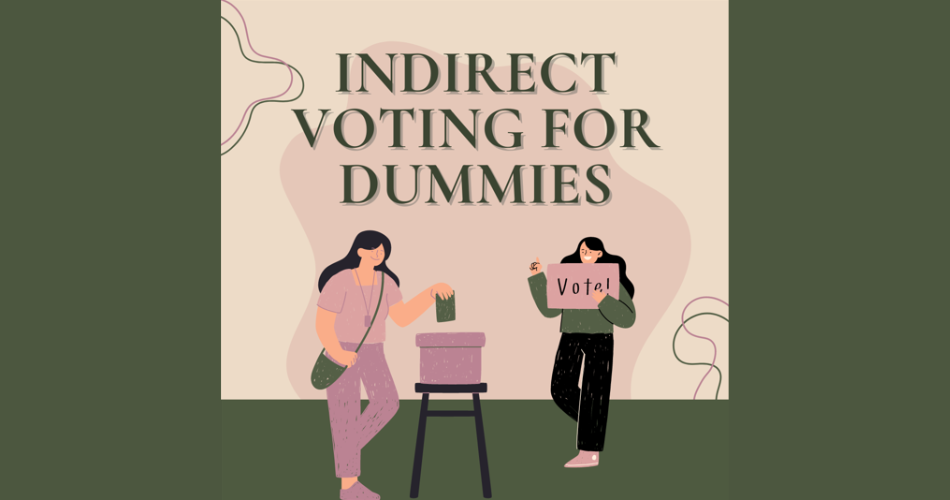Indirect voting can initially appear complex, but it plays a crucial role in the electoral systems of many countries. This comprehensive guide will clarify the concept, detailing its operational mechanisms, the key figures involved, and the reasons some political systems favor this approach. By the end of this article, you will have a thorough understanding of indirect voting, enabling you to engage in informed discussions on the topic.
An Alternative Voting Method: Understanding Indirect Voting
Indirect voting is a system where citizens do not directly vote for candidates running for specific offices. Instead, they elect representatives who then make the final decisions or votes. This method has historical roots and is still used in various forms around the world.
How Indirect Voting Operates
In an indirect voting system, the election process involves multiple stages. Initially, voters elect a group of representatives or electors. These representatives then vote on behalf of the people to select the actual officeholders. For example, in the United States, the Electoral College system means that voters cast ballots for electors, who then choose the president. Similarly, in parliamentary systems like those in Germany and Italy, voters elect members of parliament who subsequently select the prime minister or head of government.
The Purpose of Indirect Voting
The primary goal of indirect voting is to balance representation and encourage thoughtful deliberation. This system can prevent a candidate with widespread but shallow support from winning solely based on the popular vote, fostering broader consensus. It also allows for more detailed consideration of candidates and often involves multiple layers of decision-making, which can contribute to more stable governance.
In many countries, indirect voting is also used for selecting members of upper legislative houses or senates. For instance, in India and France, members of the upper house are chosen by the lower house or executive branch, rather than through direct elections by the populace.
Pros and Cons of Indirect Voting
While indirect voting introduces an additional layer to the electoral process, it comes with both benefits and challenges. Supporters argue that it promotes stability and can prevent sudden, drastic changes in policy with each election. However, critics argue that it can limit the direct influence of the populace and sometimes result in outcomes that do not align with the majority’s preferences, as seen in certain U.S. presidential elections.
Both direct and indirect voting systems have their strengths and weaknesses. Understanding these nuances is crucial for informed and active participation in the democratic process.
Examples of Indirect Voting Systems
The U.S. Electoral College
A notable example of an indirect voting mechanism is the Electoral College used in U.S. presidential elections. On Election Day, American voters select electors rather than voting directly for presidential candidates.
Following the election, these electors meet in their respective state capitals to cast their official votes for President. These votes are then forwarded to Congress, which officially declares the winner. Although the Electoral College usually reflects the results of the national popular vote, there have been notable exceptions, such as the 2000 election, where the popular vote winner did not assume the presidency.
Parliamentary Systems
In parliamentary democracies, such as those in the United Kingdom, Canada, and Australia, the Prime Minister is indirectly chosen. The Prime Minister is the leader of the political party that commands a majority in the lower house of the legislature. Similarly, in Germany, the Federal Chancellor is elected indirectly by the Bundestag, which is the lower house directly elected by the people.
Indirect Legislative Elections
Several countries utilize indirect elections for their legislative bodies. For instance, in France, the Senate is composed of members elected indirectly by “grand electors,” who are local officials rather than through a direct public vote. In India, members of the Rajya Sabha (the upper house of Parliament) are elected by state legislative assemblies instead of the national electorate.
China’s Indirect Presidential Election
China offers another example where the presidential election is indirect. In China, the President is chosen by the National People’s Congress, rather than through a direct, nationwide election by the populace.
Advantages & Disadvantages
Understanding Indirect Voting
Indirect voting, commonly known as the Electoral College system in the United States, is a method where citizens vote to elect a group of electors. These electors are then responsible for casting the official votes to determine the winner of an election. This system is primarily used for electing the U.S. president.
Benefits of Indirect Voting
- Representation for Smaller States: The Electoral College ensures that smaller states have a voice in the presidential election process. This system prevents the election outcome from being dominated solely by more populous states, thus maintaining a balance of influence among all states.
- Encouragement of Broad-Based Campaigning: To win the presidency, candidates must campaign across a diverse array of regions rather than focusing exclusively on densely populated urban areas. This broad campaign strategy helps to highlight and address issues pertinent to both rural and urban voters.
- Clearer Election Outcomes: The system is designed to produce a definitive winner, which can facilitate a smoother transition of power and reduce the potential for disputed results.
Challenges of Indirect Voting
- Discrepancies with the Popular Vote: There have been instances, such as in the 2000 and 2016 elections, where the candidate who won the Electoral College vote did not secure the most popular votes nationwide. This discrepancy raises concerns about the democratic principle of “one person, one vote.”
- Focus on Swing States: The outcome of the election often hinges on a few pivotal swing states. As a result, candidates may concentrate their efforts on these competitive states, potentially neglecting the interests and concerns of voters in states that are less likely to influence the final result.
- Risk of Faithless Electors: Although uncommon, there is a risk that some electors may not vote in alignment with the popular vote of their state, creating potential challenges to the expected electoral outcome.
This nuanced system of indirect voting plays a significant role in shaping U.S. presidential elections, balancing state influences and campaign strategies while also presenting certain democratic challenges.
Conclusion:
Indirect voting systems may seem complex, but they play an essential role in shaping governance and representation. By grasping how these systems work, individuals become more informed voters and active participants in democracy.Knowledge fosters discussions around electoral reforms and encourages civic engagement.
Keep connected for the latest updates and alerts on: Trendrevolve








Leave a Reply